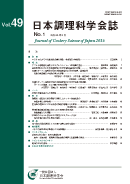All issues

Volume 49 (2016)
- Issue 6 Pages 341-
- Issue 5 Pages 297-
- Issue 4 Pages 262-
- Issue 3 Pages 187-
- Issue 2 Pages 101-
- Issue 1 Pages 1-
Predecessor
Volume 49, Issue 6
Displaying 1-8 of 8 articles from this issue
- |<
- <
- 1
- >
- >|
Review
-
Yuki Ito2016 Volume 49 Issue 6 Pages 341-347
Published: 2016
Released on J-STAGE: December 19, 2016
JOURNAL FREE ACCESSDownload PDF (1426K)
Original paper
-
Takako Yamazaki, Hajime Iwamori, Naoko Ito2016 Volume 49 Issue 6 Pages 348-354
Published: 2016
Released on J-STAGE: December 19, 2016
JOURNAL FREE ACCESSMeat is one of the important dietary protein sources. However, meat becomes tough on heating, making it hard to be eaten by elderly people, who have decreased chewing and deglutition capacity. The aim of this study was to develop beef cooking methods for such consumers, using maitake (Grifola frondosa). The rupture stress of beef steamed at 70°C with maitake extract was significantly lower compared with that of untreated beef. Sensory evaluation showed that beef cooked under vacuum with maitake extract (mvp) was tender, but the surface of the beef was sticky. The tenderness of beef injected with maitake extract and cooked was the same as that of beef cooked by mvp method, but it was less sticky. SDS-PAGE and western blotting indicated that protease in the maitake hydrolysed myosin. These results suggested that beef injected with maitake extract had good texture and was easy to be eaten by elderly people.View full abstractDownload PDF (1100K)
Note
-
Naomi Shibata-Ishiwatari, Megumi Kawaguchi, Yoshimichi Ando, Mikio Ina ...2016 Volume 49 Issue 6 Pages 355-361
Published: 2016
Released on J-STAGE: December 19, 2016
JOURNAL FREE ACCESSRaw okara, a by-product of tofu manufacturing, is richly nutritious, but is typically discarded. We endeavoured to develop a processed cereal-like food containing 70% raw okara by weight, in order to mitigate the problems associated with the mass disposal of raw okara, and to provide a healthy breakfast alternative. Samples were heated at 100°C, 120°C, or 150°C, and then the moisture content, water activity, breaking stress, colour, and change in weight after soaking in milk, were measured. The appearance of the sample surface was also noted. The equivalent measurements were made for commercially available products to evaluate sample quality. The results showed that the resulting processed cereal-like food, containing 70% raw okara by weight, was, with the exception of its hardness after heating at 100°C for 90 to 120 min, similar in quality to commercially available products.View full abstractDownload PDF (1200K)
Technical report
-
Dietary Customs Concerning Three Types of Shad Fish in the Southern Region of the Okayama PrefectureSatsuki Une2016 Volume 49 Issue 6 Pages 362-370
Published: 2016
Released on J-STAGE: December 19, 2016
JOURNAL FREE ACCESSOver the past few centuries, three types of fish, slender shad (Ilisha elongata), Japanese shad (Sardinella zunasi), and dotted gizzard shad (Konosirus punctatus) have been mainly eaten in the southern region of the Okayama prefecture of Japan. The objective of this study is to highlight dietary customs in Okayama surrounding the consumption of these fish.
All three types of fish have often been eaten pickled, as sushi, or baked, and slender shad has been simmered and eaten in modern times. All of these methods were inherited from the Edo period. These fish were seen as special products in the Okayama clan and have been used to show hospitality on special occasions. However, they have not been used when serving guests of high position. Through the handing down of recipes, other eating habits from the Edo period were also inherited by the southern region of the Okayama prefecture.View full abstractDownload PDF (1123K)
Course text
-
Mariko Ikeya2016 Volume 49 Issue 6 Pages 371-376
Published: 2016
Released on J-STAGE: December 19, 2016
JOURNAL FREE ACCESSDownload PDF (1012K)
Educational materials research
-
Miho Kawamura2016 Volume 49 Issue 6 Pages 377-380
Published: 2016
Released on J-STAGE: December 19, 2016
JOURNAL FREE ACCESSDownload PDF (792K)
Cooking room
-
Kanto Branch Manufacturing Process and the Recipes of “Sudare-bu” in Yuki city, IbarakiYuko Hisamatsu, Motoko Awazuhara (Noguchi)2016 Volume 49 Issue 6 Pages 381-385
Published: 2016
Released on J-STAGE: December 19, 2016
JOURNAL FREE ACCESSDownload PDF (1289K)
Topics & opinion
-
Hidenori Sato2016 Volume 49 Issue 6 Pages 386-387
Published: 2016
Released on J-STAGE: December 19, 2016
JOURNAL FREE ACCESSDownload PDF (980K)
- |<
- <
- 1
- >
- >|